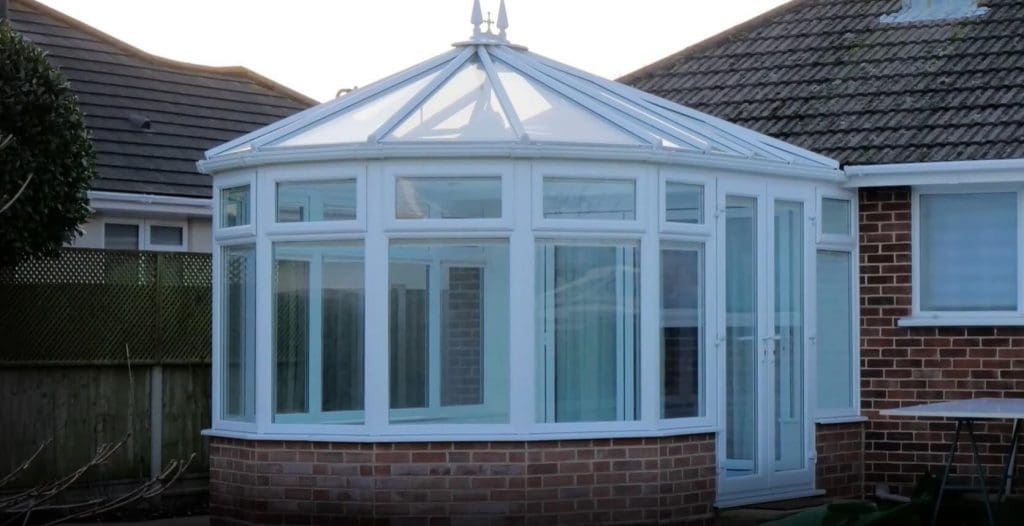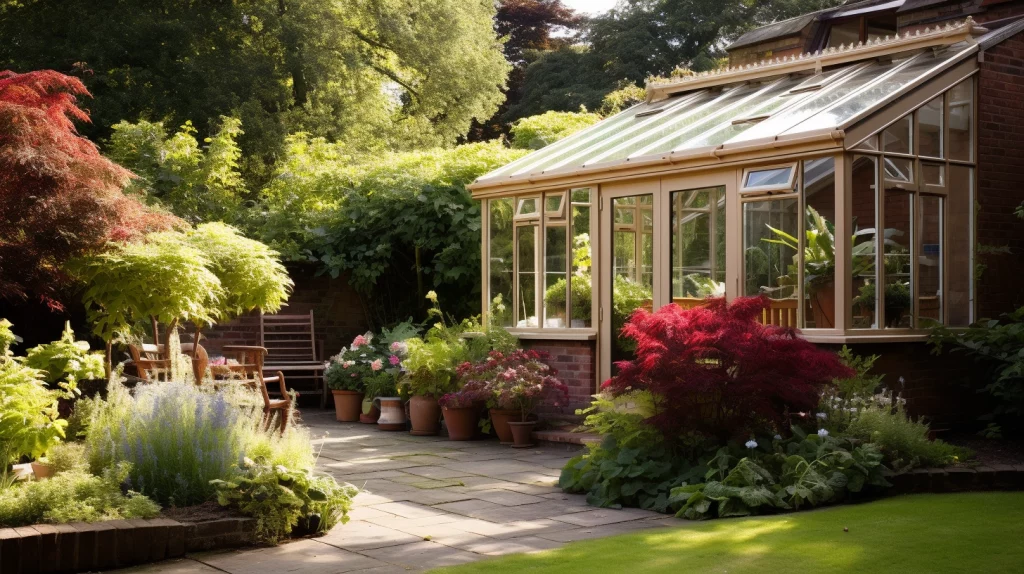When upgrading your conservatory, choosing between a complete roof replacement and a more cost-effective solution like thermal roof panels from CosyPanels®, it is important to understand the different processes and what they offer.
Here, we’ll take you through the pros and cons of each conservatory roof replacement option, providing details to help you decide which option matches your needs and preferences.
How often should you replace a conservatory roof?
Before looking into the replacement options, it’s important to know the lifespan of a typical conservatory roof. The length of time between replacements depends on the type of conservatory you have, which material is used, the surrounding environment and climate, and the frequency of maintenance.
When to replace a polycarbonate roof
These roofs may require replacement every 10 to 15 years, as they can deteriorate over time, leading to issues like discolouration, reduced insulation, and issues with condensation.
There are several reasons polycarbonate roofs may need replacing:
- Weathering: harsh weather conditions, such as intense sunlight, extreme temperatures, hail, and heavy rain, can cause polycarbonate to degrade over time. UV radiation, in particular, can lead to yellowing and reduced transparency, compromising the aesthetic and functional qualities of the material.
- Scratching and abrasion: Polycarbonate can be susceptible to scratching, especially when in contact with abrasive materials or is cleaned using harsh chemicals. Over time, scratches can gather and affect the overall clarity of the material.
- Chemical exposure: Certain chemicals can react with polycarbonate and cause it to degrade. For example, exposure to some cleaning agents or chemicals can lead to discolouration or other forms of deterioration.
- Impact damage: While polycarbonate is generally impact-resistant, severe impacts or repetitive stress from falling objects (such as hail or tree branches) can cause damage that may warrant replacement. Small cracks or fractures can compromise the roof’s structural integrity and water resistance.
- Ageing: Like any material, polycarbonate roofs can age with time. As they age, they may become more brittle, lose flexibility, and experience a decrease in overall performance.
- Poor installation: Incorrect installation can lead to various issues, including leaks, poor drainage, and structural problems. If a polycarbonate roof is not installed properly, it might require replacement to address these issues.
- Maintenance issues: Lack of regular maintenance can contribute to the deterioration of a polycarbonate roof. Proper cleaning and inspection can help identify potential problems before they become severe.
If you notice signs of deterioration, it’s advisable to consult with a roofing professional to assess whether replacement is necessary.
When to replace a glass roof
With proper care, glass roofs can last longer, but breakages or wear and tear may necessitate replacement after 20 to 25 years. Some glass roofs are poorly insulated, and the heat from the home is quickly lost. There are several other reasons why they may need replacing:
- Overheating: Issues with overheating can also lead people to seek alternatives to replace glass roofing early. The glass roof absorbs and retains the sun’s heat, creating an uncomfortable environment and often an unusable conservatory.
- Many glass roofs are constructed with sealed units (double or triple glazing) to enhance insulation. If the seals on these units fail, moisture can get into the space between the glass panes, leading to condensation, reduced thermal efficiency, and potential damage to the glass.
- In some cases, older glass roofs may use outdated technology or materials that do not meet modern energy efficiency standards. Replacement may be necessary to upgrade to more energy-efficient and technologically advanced options.
- If the existing glass roof does not meet security standards or is vulnerable to break-ins, replacement with more secure glass or alternative materials may be required.
It’s important to regularly inspect glass roofs for signs of damage, wear, or ageing. If you have any concerns, get a professional to assess it for the best advice on moving forward with your replacement.
Which conservatory roof replacement is the best?
When considering a conservatory roof replacement, you’ll encounter various options, each with advantages and drawbacks. Although polycarbonate roofs might be more cost-effective, glass conservatories may offer better insulation, but tiled or solid roofs typically last much longer. Here are some considerations for each type of conservatory roof replacement:
Polycarbonate Conservatory Roof Replacement
Pros: Cost-effective, lightweight.
Cons: Limited insulation, potential discolouration over time.
Planning Permission: Generally, polycarbonate roofs don’t require planning permission, but always check with your local planning authority to determine whether the replacement falls within permitted development rights or if you need formal approval.
Energy Efficiency: Polycarbonate roofs offer a low standard of thermal insulation. Consider upgrading the insulation of the new roof to improve energy efficiency. This may involve choosing a polycarbonate roof with enhanced thermal properties or exploring alternative materials like insulated roof panels.
Maintenance Requirements: Some polycarbonate roofs may require less maintenance than others, depending on external factors and which form it is (twin wall, multiwall, solid, etc). They may need regular cleaning to clear debris and remove stains.
Durability and Longevity: Select high-quality polycarbonate or alternative roofing materials that offer a longer lifespan. A more durable roof may require less frequent replacement and maintenance.
Aesthetic Considerations: Ensure that the replacement roof complements the overall aesthetic of your home and fits in with the house style. Although there are variations in polycarbonate panel style, many prefer the look of alternative, more traditional roofing materials.
Ventilation and Condensation: Proper ventilation helps control condensation and maintains a comfortable environment. Your replacement roof should facilitate adequate airflow.
Budget and Financing: Polycarbonate roofing can be economical but remember to factor in any potential long-term savings from energy-efficient options.

Glass Conservatory Roof Replacement
Pros: Improved aesthetics & better insulation.
Cons: Higher cost and the potential for heat loss in colder months.
Planning Permission: Verify whether local regulations require planning permission for glass conservatory roof replacements. In many cases, changing a glass conservatory roof may not require planning permission, especially if the alterations fall within your property’s permitted development rights.
However, there are conditions and limitations that you should consider., and some regions may have specific rules regarding using glass or other materials in conservatories.
Type of Glass: Decide on the type of glass for the replacement. Options may include standard glass, low-emissivity (low-E) glass for better insulation, or solar control glass to reduce heat and glare.
Energy Efficiency: Upgrade to double or triple glazing to enhance insulation and thermal performance. This can help regulate temperatures inside the conservatory, making it more comfortable throughout the year.
Maintenance Requirements: Consider the maintenance needs of different glass types. Self-cleaning glass or glass with special coatings may reduce the frequency of cleaning, making maintenance more convenient.
Solar Control and UV Protection: Explore glass options with coatings for glare reduction and UV protection and glare reduction. This is particularly important for maintaining a comfortable interior and protecting furniture and flooring from sun damage.
Ventilation and Condensation: Consider ventilation options, such as roof vents, to prevent condensation on the glass. Adequate ventilation helps maintain a clear view and a pleasant environment inside the conservatory.
Aesthetics: Ensure that the replacement glass roof complements the architectural style of your home. Consider factors like frame colour and design to seamlessly fit the overall aesthetic.
Budget and Financing: While high-quality glass may have a higher upfront cost, the long-term benefits and energy savings should be considered as part of your investment – also, factor in the long-term costs associated with the upkeep of glass roofing.
Regulatory Compliance: Check that the replacement glass roof complies with safety standards. Confirm that the glass meets necessary regulations for wind resistance, fire safety, and other safety considerations.
Solid Conservatory Roof Replacement
Pros: Good insulation, reduced noise, durable.
Cons: Requires planning permission, heavier load on the structure.
Planning Permission: Verify local planning regulations to determine whether replacing a conservatory roof with a solid option requires planning permission. In some cases, it may be considered a significant alteration, necessitating approval.
Insulation and Energy Efficiency: A solid roof generally provides better insulation than a glass or polycarbonate roof. Consider how this improved thermal performance aligns with your energy efficiency goals.
Ventilation and Condensation: Solid roofs can reduce natural ventilation, potentially leading to condensation issues. Ensure the replacement design includes proper ventilation features to maintain a comfortable environment.
Overall Look: Think about how a solid roof integrates with your home’s existing architecture. It can provide a more traditional and solid appearance but should work with the overall design.
Lighting Considerations: Since solid roofs limit natural light, plan for alternative lighting solutions, such as roof lights or strategically placed windows, to maintain a well-lit interior.
Tiled Conservatory Roof Replacement
Pros: Good insulation, reduced noise, durable.
Cons: Requires planning permission, heavier load on the structure.
Planning Permission: Similar to a solid roof, replacing a conservatory roof with tiles may trigger planning permission requirements. Verify local regulations to ensure compliance.
Insulation and Energy Efficiency: Tiled roofs often provide excellent insulation, contributing to improved energy efficiency. Think about the thermal properties of different tile materials and designs.
Ventilation and Condensation: Like with a solid roof, plan for adequate ventilation to prevent condensation. This may involve incorporating roof vents or other ventilation features into the replacement design.
Weight Considerations: Tiles can add weight to the structure, and it’s important to ensure that the existing conservatory structure can support the additional load. Consult with a structural engineer if necessary.
Maintenance: Tiled roofs may require periodic inspection to ensure that tiles are secure and in good condition. Plan for regular maintenance to address any issues promptly.
Cost Considerations: Remember to consider costs of both materials and labour. Factor in long-term energy savings and maintenance requirements.

CosyPanels: the best conservatory roof replacement
Pros: Lightweight, excellent insulation, reduced condensation, cost-effective.
Cons: It may not apply to all conservatory roofs – contact us to check if you’re eligible.
Planning Permission: Generally, CosyPanels® don’t require planning permission, but always check with your local planning authority to see whether the replacement falls within permitted development rights or if you need formal approval.
Material and Design: Ensure that Cosy Panels are suitable for use in your area and comply with local building codes. Some areas may have restrictions on certain roofing materials or designs, so verifying compliance is essential.
Installation Professional: CosyPanels® are installed by experienced and qualified professionals. Installers complete a full roof assessment and talk you through the installation process, ensuring you are happy before work begins.
Maintenance Requirements: Cosy Panels are designed to be durable and low maintenance.
Energy Efficiency: CosyPanels® are designed to improve insulation and reduce energy consumption, leading to potential cost savings over time.
Warranty: CosyPanels® come with a full 10-year guarantee.
How much does a replacement conservatory roof cost?
The cost of a replacement conservatory roof can differ greatly based on factors such as the material chosen, the size of the conservatory, and additional features like insulation.
Polycarbonate Roof Replacement: According to Checkatrade, prices can vary greatly depending on labour and circumstance, but as a guide, the ranges can vary between £4,200 at the low end for a 3m by 3.5m roof to £8,400 at the high end. For larger projects measuring around 5m by 5m, the costs range from £10,000 to £20,000.
Glass Roof Replacement: This cost can also be affected by many factors, but for the same project of 3m by 3.5m, it starts at around £6,300 and can reach £12,600. For the larger project of 5m by 5m it ranges between £15,000 – £30,000.
Solid or Tiled Roof Replacement: Again, prices can vary, but start around £16,000 for a smaller project and £30,000 or more, considering additional structural work, for a larger project. Replacing or fitting a new solid/tiled roof on a conservatory typically takes between 1-3 days to complete the job, so labour costs for solid/tiled roof is usually between £300 – £500 per person per day.
Cosy Panels cost: Cosy Panels is a more cost-effective alternative to standard conservatory roofs, potentially saving you thousands compared to a complete roof replacement. The installation requires no structural change, has a 10-year guarantee and is fitted in just one day. Cosy Panels prices start at £3,146, but can vary depending on several factors, so for a more accurate cost request a quote.
CosyPanels® vs Conservatory Roof Replacement
Let’s compare the two primary options: CosyPanels® and a traditional conservatory roof replacement.
Conservatory Roof Conversion Pros and Cons
Pros:
- Enhanced aesthetics.
- Potential increase in property value.
- Improved insulation and energy efficiency.
Cons:
- Far higher cost.
- Longer installation time.
- Planning permission may be required for certain types.
CosyPanels® Pros and Cons
Pros:
- Cost-effective.
- Quick installation – just one day.
- Excellent insulation.
- Reduced condensation.
- Lightweight design.
- Attractive finish.
Cons:
- It may not be suitable for certain types of conservatory roofs.
After weighing up the advantages and drawbacks of a traditional conservatory roof replacement, in comparison to the innovative CosyPanels® system, if you’re leaning toward upgrading your conservatory experience with CosyPanels®, take the next step by requesting a complimentary quote, or call us on 0800 75 66 882.
Discover the potential savings and benefits you can receive with CosyPanels® today and restore the functionality and aesthetic appeal of the conservatory you’ve been dreaming of.


